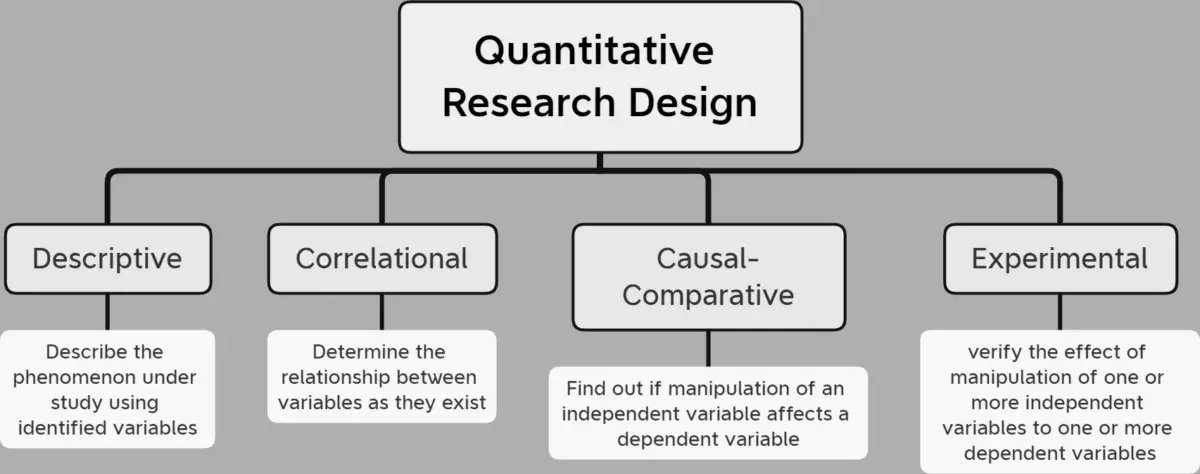What is the quantitative research design? Why is the research design needed? What are the four main types of quantitative research designs used by researchers?
This article illustrates research design using an analogy, explains why a research design is needed, describes four main types of research designs, and gives examples of each research design’s application.
In doing your research on whatever goals you have in mind, you make a plan to reach those goals. You spell out the specific items that you want to pursue in your research objectives.
An Analogy of Research Design
Researching to reach a predetermined goal is like building a house. To avoid costly rebuilding, it would be a good idea to make a plan first and consider all the requirements to produce one that appeals to your taste.
You need to engage the architect’s help to draw what you have in mind (your concept), estimate the cost to build it, and list the steps to follow to bring that plan into reality. The architect comes up with a blueprint of the house, detailing the size and quantity of reinforced steel bars, the floor plan, dimensions of the house, and aesthetics.
If your house comprises not only one floor but two, or even three, and you want the house to be sturdy, that could last decades or generations; you will need to engage a structural engineer. He makes sure that the home maintains its integrity and can handle the loads and forces they encounter through time.
And, of course, the electrical connections require the expertise of an electrical engineer. He plans how the electrical circuits are arranged in the entire house to make it convenient for you to access electricity.
To build your dream house, you will need to have a good plan–your design.
Why is a Research Design Needed?
As pointed out earlier, the main reasons for coming up with a research design relate to efficiency and effectiveness. If you have a good research design, you will save time, energy, and cost in doing your research. You have a plan to get the data that you want to answer the research objectives.
Thus, before conducting research, you already have in mind what to expect. And of course, you will know how much that would cost you. If you cannot afford it, then you revise your plan.
Defining the Research Objectives
However, your research design or plan cannot be carried out if you don’t have a clear idea about what you want. The architect cannot design a project based on a simple directive to make a house plan. The outcome may not be to your liking, and you will just be wasting your money and his time. It will be a hit-and-miss approach.
Thus, you will need to define your research objectives based on your topic of interest. What do you want to achieve in your research? Will you be dealing with people, animals, plants, or things?
Will you manipulate some variables? Will you compare different groups? Would you want to know which variable causes an effect on other variables? Or will you describe what is there?
It all boils down to what you want. Be very clear if you’re going to describe things, correlate them, find out if one causes the other, or put up an experiment to test if manipulating one variable can effect a change to another variable.
Now, here are the four quantitative research designs.
The Four Main Types of Quantitative Research Design
Experts classify quantitative research design into four types. These are descriptive, correlational, causal-comparative, and experimental research.
The four quantitative research designs are distinguished from each other in Figure 1. Please note that as you go from left to right; the approach becomes more manipulative. The descriptive research design studies the existing situation, whereas the researcher manipulates variables at the other end, using the experimental method.

Quantitative research design examples are given for each of the four quantitative research designs in the next section.
Examples of the Application of the Different Research Design on the Same Subject
Descriptive Research Design
A willingness to pay (WTP) study aimed to determine the vehicle owner’s knowledge about air quality and attitude towards the government’s regulation of requiring emission testing every time the car’s registration is renewed. This investigation will provide information that will show how knowledgeable the respondents are about air quality and reveal patterns of behavior towards the government’s measures to control carbon emissions. It explores the drivers’ willingness to pay for vehicle maintenance costs.
Correlational Research Design
The same study on air quality may be conducted as in Example 1, but this time, the respondent’s awareness about air quality is correlated with their attitude towards emission testing.
The study by Amindrad et al. (2013) on the Relationship Between Awareness, Knowledge and Attitudes Towards Environmental Education Among Secondary School Students in Malaysia exemplifies this research design.
Causal-Comparative Research Design
Still, on the air quality study, you might want to know what causes the respondents to behave positively or negatively towards emission testing. Does attitude have something to do with a person’s educational background? Or perhaps, their capacity to pay for emission testing?
The following video explains this research design further with two examples.
Experimental Research Design
Using still the air quality study, you might now want to test if two groups of drivers behaved differently when one group was required to attend a seminar on air pollution, and the other group was not required to attend.
The two groups’ members were randomly assigned, and all other variables were kept constant, meaning the respondents have similar characteristics where only attendance at the seminar is the difference.
You are interested in finding the difference between a person’s attitude towards emission testing. And what discriminates them from the other is that one group attended a seminar on air pollution while the other group did not.
Final Notes
Note that those listed are not mutually exclusive research designs. We can combine them.
For example, you can undertake a study that uses both a descriptive and a correlational research design. Hence, you describe this approach in your methodology as a descriptive-correlational research design.
That wraps it up.
There are still other types of research designs out there. What is important here is that you are clear about what you want to investigate.
Reference
Aminrad, Z., Zakariya, S. Z. B. S., Hadi, A. S., & Sakari, M. (2013). Relationship between awareness, knowledge and attitudes towards environmental education among secondary school students in Malaysia. World Applied Sciences Journal, 22(9), 1326-1333.
© 2020 October 15 P. A. Regoniel, updated 27 November 2021
[cite]


